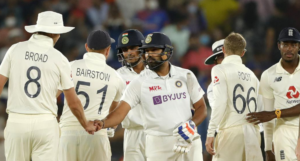Introduction
Test cricket, often referred to as the purest form of the game, is a thrilling and timeless battle of skill, strategy, and endurance. With matches that can last up to five days, it is the ultimate test of a cricketer’s abilities. In this blog, we will explore the fundamental rules that govern Test cricket, from the structure of a match to scoring, dismissals, and more.
The Format: Five Days of Intense Action
- Duration of a Test Match
Teams play test matches for a maximum of five days, with six hours of play scheduled for each day, divided into three sessions: morning, afternoon, and evening. Nevertheless, if a result is attained sooner (either due to a victory or a draw), the match may end before the fifth day.
- Number of OversIn a Test match, there is no fixed number of overs per team. Instead, each team has the opportunity to bat until they are dismissed, declaring their innings at their discretion.
Scoring Runs
- Runs and BoundariesIn Test cricket, players accumulate runs by executing singles, twos, threes, and boundaries (fours and sixes). A boundary occurs when a ball reaches or crosses the boundary rope. A four is granted when the ball crosses the boundary on the ground, while a six is awarded when it crosses the boundary without touching the ground.
- ExtrasExtras in Test cricket include byes, leg byes, no-balls, and wides.Batsmen score runs without making contact with the ball when they earn byes and leg byes. Deliveries that result in extra runs as penalties are called no-balls and wides, and in the case of no-balls, the batting team also gets an additional ball.
Dismissals
- Wickets and Modes of DismissalBatsmen can be dismissed in various ways in Test cricket, including:
- Bowled: When the bowler hits the stumps directly, dislodging the bails.
- Caught: If the ball is caught by a fielder without it touching the ground.
- LBW (Leg Before Wicket): When the ball would have hit the stumps but is intercepted by the batsman’s leg or body.
- Run Out: When the fielding team successfully removes the bails while the batsmen attempt a run.
- Stumped: When the wicketkeeper removes the bails while the batsman is out of their crease and not attempting a shot.
- Hit Wicket: If the batsman accidentally dislodges the bails with their own equipment or body.
- Retired Hurt: A batsman can retire due to injury and may return to bat later if fit.
- Timed Out: If a new batsman does not arrive at the crease within a specific time after the previous dismissal.
Fielding and Bowling
- Fielding PositionsFielding positions in Test cricket can vary widely, but some common positions include slip, gully, point, cover, mid-off, mid-on, midwicket, square leg, and fine leg. These fielders are strategically placed to capture catches, stop boundaries, and create pressure on the batsmen.
- BowlingBowlers aim to dismiss batsmen by delivering the ball within the rules of the game. They use various techniques, including pace, spin, swing, and seam movement, to deceive and outsmart the batsmen.
Follow-On and Declarations
- The Follow-OnIn Test cricket, if the team batting first establishes a significant lead (usually 200 runs or more) over the opposing team’s first innings total, they may enforce the follow-on. This means the opposing team must bat again immediately, with the aim of leveling the score or taking the lead.
- DeclarationsA team captain can declare their team’s innings closed at any point during the match, allowing them to set a target for the opposing team. Declarations are often strategic decisions, aiming to maximize the chances of winning.
Umpires and Decision Review System (DRS)
- UmpiresTest matches are officiated by two on-field umpires and a third umpire in the video replay booth. The on-field umpires are responsible for making decisions in real-time, while the third umpire reviews certain contentious situations.
- Decision Review System (DRS)DRS is a technology-assisted system that allows teams to challenge umpiring decisions. It includes tools like ball tracking (Hawkeye) and hotspot technology to provide a more accurate assessment of dismissals and contentious decisions.
Result Outcomes

- Possible ResultsA Test match can end in one of four outcomes:
- Win: One team wins by dismissing the opposing team twice or by successfully chasing a target.
- Loss: A team loses when it dismisses twice or fails to chase the target.
- Draw: The match concludes without a winner, often due to time constraints or weather interruptions.
- Tie: A rare occurrence where both teams finish with the same score in both innings.
Conclusion
Test cricket, with its unique format and rules, remains the pinnacle of the sport. It challenges players’ skills, endurance, and mental fortitude over five days of intense competition. Understanding these fundamental rules is essential for appreciating the nuances and excitement of this remarkable form of cricket, where every ball and every run can make the difference between victory and defeat.
Read More:




